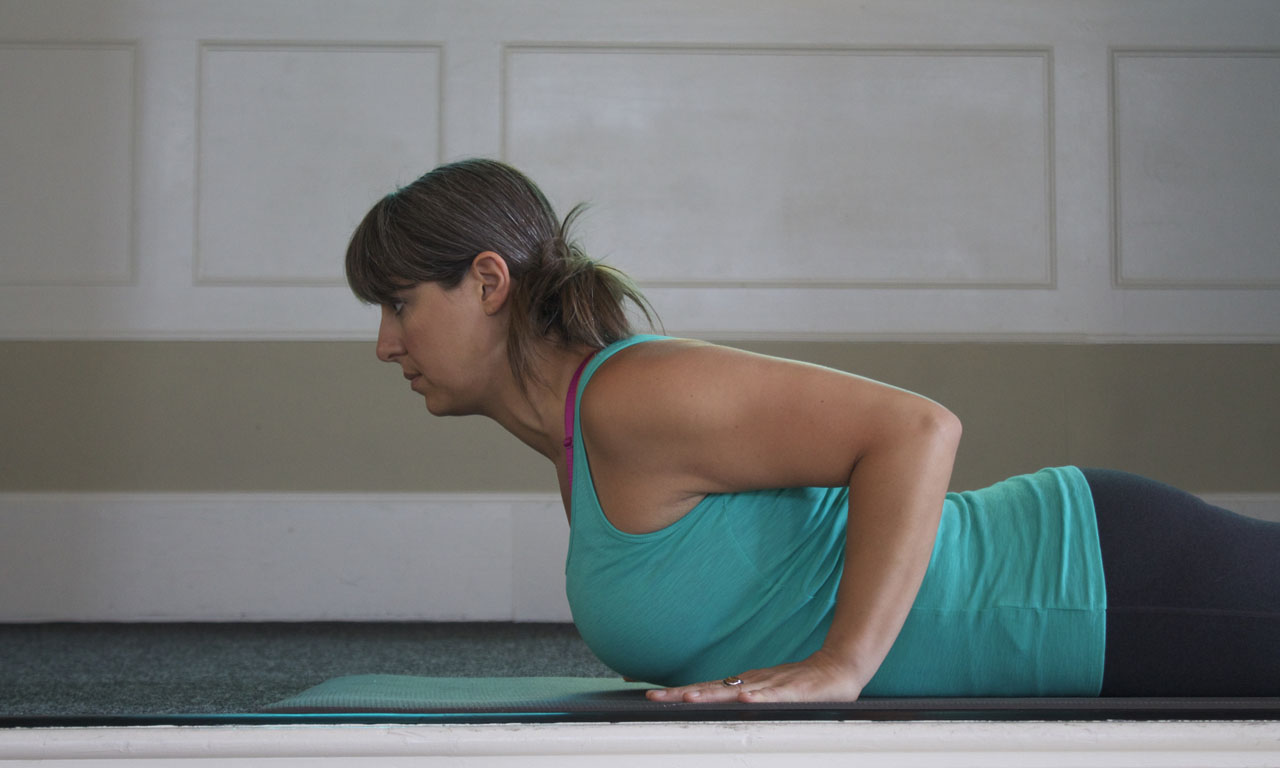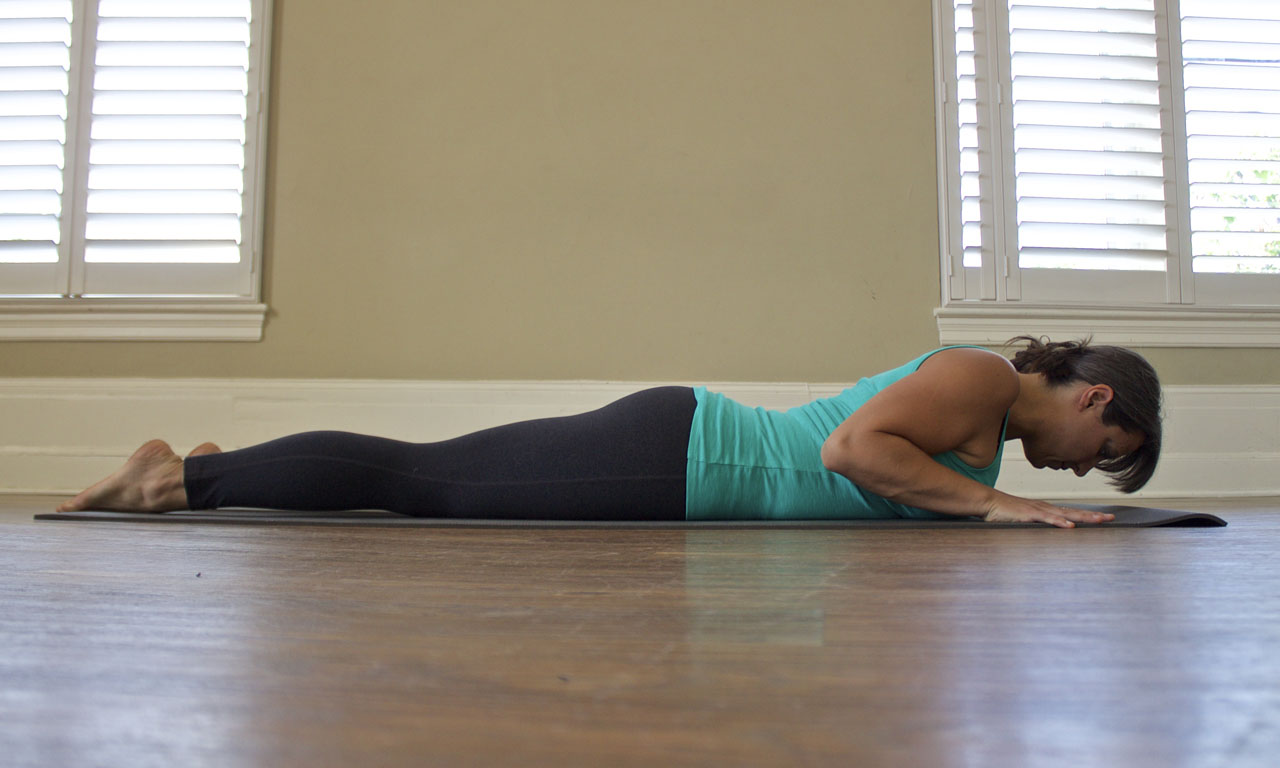Cobra Pose
Bujangasana exemplifies the effort of the upper back in back bending.
As a precursor to Upward Facing Dog, Cobra is the first backbend many of us practice. Maybe it’s just a warm-up, or perhaps we use it as a foundation pose of “the vinyasa”. It is practiced in abundance and across the spectrum of yoga styles. I’m concerned, however, about HOW it is practiced.
I see students in class with their hands under their shoulders and pushing the heart up and back, using all the strength in their arms to get higher and higher, tipping their heads back at break-neck angles — their legs straining as their feet push down into their mat and their Glutes squeezing every last drop of energy out of their poor little tailbones. Meanwhile, their vertebrae are mashed together and jam into the brick wall of the clenched Gluteus Maximus, and they wonder why they have back pain later.
What if you could practice a Cobra that felt truly liberating for your spine, your heart and your breath? What if you could feel the muscles of your back body work together from top to tail in an integrated fashion, so that your arms weren’t even needed, and your legs were active without your Glutes needing to be in a death-grip on your sacrum, and your breath was free flowing and the word “straining” never ever crossed your mind?
I think you can do it, having done it myself, but you may need to rethink a few basic principles before you get started. Cobra is a back bend, not a back break. The object is to create the longest, smoothest curve you can from the base of the spine to the base of the skull. There is nothing good that can come from a spine that breaks in two at its most mobile point, only degeneration and dysfunction. Boo. So if your spinal muscles aren’t strong enough (yet) to hold the length and the height of your Cobra, using your arms to lever yourself up is not actually serving your growth, it’s crushing your spine. I urge you to build the strength slowly over many Cobra poses to find the most integral version you can. That said, the arms CAN help you in this pose, but you’ll need to place the hands precisely and engage the arms properly to integrate them into the back bending muscles.
Cobra is about using the spinal muscles, not pushing yourself up with your hands. Place hands under elbows for good leverage in the PULLING action that activates the Lats.
When hands are aligned under the shoulders, there is no way to use the arms to help activate Lats along the mid- and low-back. You’re more likely to use arm strength to push yourself up from here.
Also, the Glutes clenching the edges of your sacrum will not help stabilize your low back. That’s a myth that is being slowly dispelled by those in the know regarding basic biomechanics. Let’s be clear. You’re doing a back bend, and even a neutral lumbar curve IS a back bend, but clenching your glutes flattens that curve…that opposes the intention of the posture. I think it makes more sense to help support the back bend that already exists in the lumbar spine.
So to these ends, I offer you the following cues to test and taste and freely experiment with. Please let me know if you have any questions.
On your belly, look straight at the floor to get the back neck long.
Use this position to close your eyes and “look” within. Some of the actions will be very subtle and your internal gaze will be helpful.
Place hands flat on floor near your ribs, wrists aligned under elbows.
This is the position you would ideally land in if you were coming from Chaturanga Dandasana AND the position from which you’ll have the most efficient leverage to eventually push up and back to your Downward Facing Dog.
Bend both knees to point toes to sky, press knees to ground with 10% effort.
This step is really an effort to find the place on the thigh which you ground down with, because many people are accustomed to pressing down their feet and pubic bones. Those actions encourage the clenching of the glutes and destabilization of the lumbar curve. By pressing your knees down instead, you actively engage the hip flexors to help lighten the tail and give it space to lengthen out of the spine if pressure builds at the sacrum. Once you become familiar with the grounding effort, you won’t need to bend the knees to find it.
Lift belly to spine with 40% effort, keep glutes soft.
The intention here is to compress the organs as a stabilizer for the lumbar/thoracic spine, NOT to shorten the space between pubic bone and sternum. The glutes may engage slightly, but never let them turn on 100%. You do not want to tuck the tail and diminish the lumbar curve, you want to support it with the hydraulic pressure of your fluid body.
Gather shoulder blades together behind heart and squeeze elbows toward spine.
Engaging the middle trapezius and rhomboid muscles will broaden the chest and create the space through which the heart will lengthen.
Pull hands back against the friction of your mat and lengthen sternum forward.
Cobra is not about getting UP, it’s about growing OUT. The action of pulling the arms/hands back engages the latisimus dorsi, a very large muscle that attaches to the lower two thirds of your spine. To contract lats is to take muscular advantage of our continuity from extremity to core. Use this mechanical advantage as your deeper intrinsic paraspinal muscles develop strength to work more on their own. It will take time, but the strength will come.
Keep vocal cords pulled gently into neck spine for support and long back neck.
You do not want to look straight ahead, that will contract the muscles at the base of the skull, cut your breath short and you’ll and fatigue quickly. Use Jalandhara Bandha in this way to support both the neck spine and the flow of breath. Lengthen the crown as a continuous arc from the back of the heart.
Find a steady, smooth breath.
Try not to clench the jaw. If you notice you’ve clenched your jaw, pressed your tongue into your teeth or pallet, or hardened your face in any way, release it and check in with your glutes…they respond reflexively to the jaw so if one is clenched, usually so is the other.
Continue, breath by breath to coil the muscles behind your heart and into the back ribs, as you lengthen the front ribs and heart forward and up.
The more the back body engages and contracts, the more the front body must support it…stay engaged in the belly and pressing down with the thighs. This will help you express your length without breaking at the mid-spine.
Keep the thighs pressing down as you lower your ankles to Earth and lengthen out through toes.
Your legs remain the roots of the pose. It is from this anchor that your heart lengthens, so don’t forget them even as you concentrate on the contractions of the spine.
Eventually you don’t need the friction of your hands and can bend elbows to lift hands from mat.
Continue to use the hands for as long as needed to build the strength of the paraspinal muscles. If you do choose to lift them, make sure you are only as high/long as can be maintained without the support of the hands. Also, when you return the hands to the mat, be sure the wrists land under your elbows and not under your shoulders. Again, this is the most efficient place from which to begin the transition to other postures.



